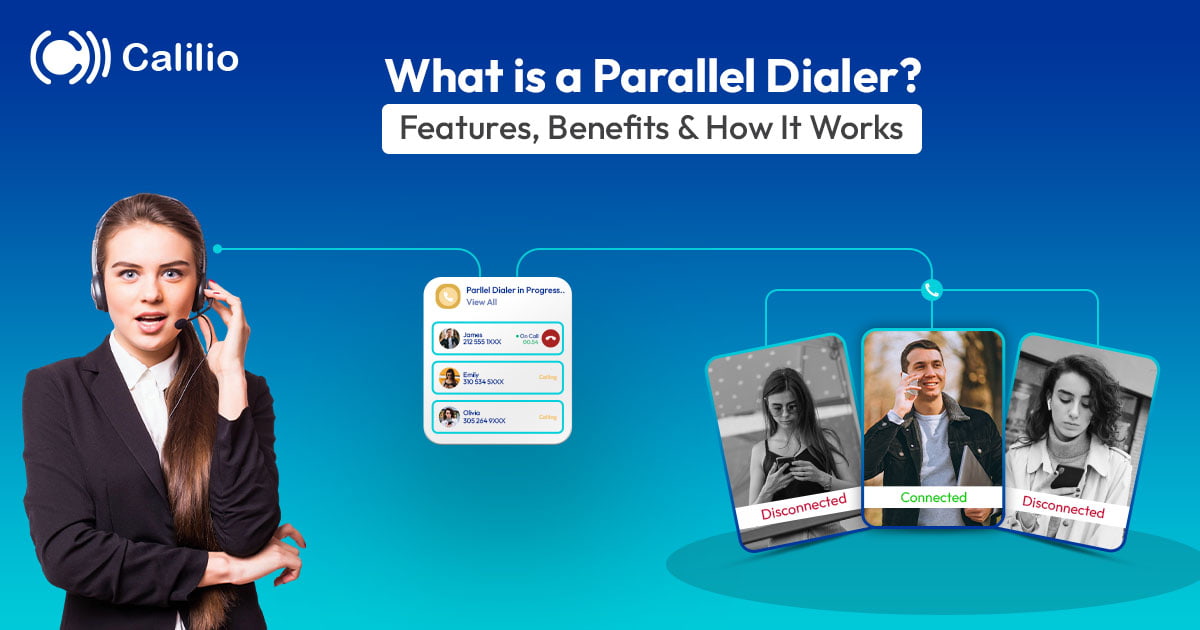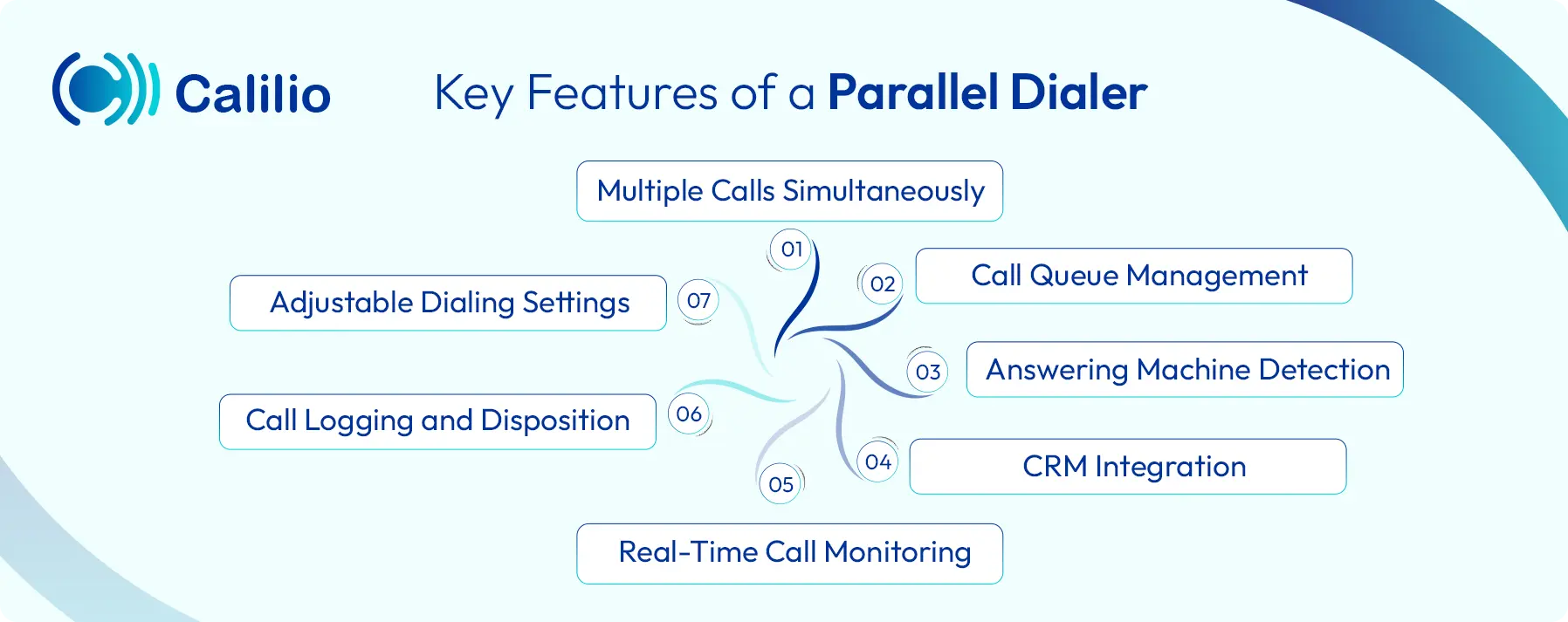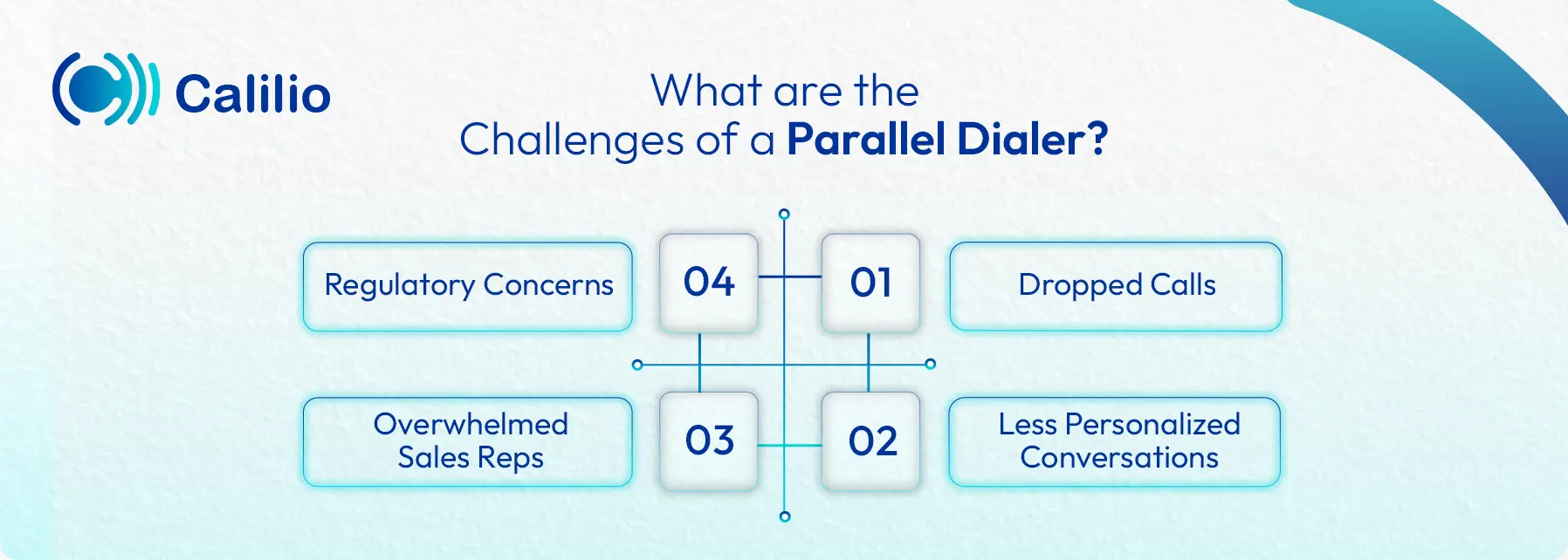What is a Parallel Dialer? Features, Benefits, Challenges, & Tips

Businesses regularly call customers for sales, support, lead generation, or follow-ups. But when agents rely on manual dialling, the process slows down. They end up spending more time waiting for someone to answer rather than actually speaking with prospects. This results in lower efficiency, missed connections, and reduced productivity.
A parallel dialer offers a smarter solution. It calls multiple numbers at once for each available agent and connects the agent only when someone answers. This keeps your agent engaged and improves overall productivity.
In this blog, we’ll explore what a parallel dialer is and how it works in detail, including its key features, benefits, and tips to use it to improve your outbound calling strategy.
Keep reading!
Key Highlights:
A parallel dialer places multiple calls at the same time per agent to maximize connections.
Some of the key features of parallel dialers include call routing, scalability, automated dialing, and voicemail detection.
Parallel dialing enhances customer engagement, connects with more clients faster, and provides real-time analytics on your call.
An unmanaged and unsystematic parallel dialing process may exhaust your agents. So, it's important to set up the tool following the right method.
To maximize parallel dialer results, balance call volume, use clean contact lists, train your agents, regularly monitor performance, and ensure compliance with telemarketing regulations.
What is a Parallel Dialer?
A parallel dialer is a type of automated outbound dialer that dials multiple phone numbers simultaneously and connects the first answered call instantly to the live agent, while dropping the other unanswered calls.
This approach helps teams reach more people in less time and maximizes productivity by reducing the wait times for agents to connect with customers. It's especially effective for high-volume outreach activities like B2B sales and telemarketing.
How Does A Parallel Dialer Work?
A parallel dialer works by launching several calls at once when an agent becomes available. As soon as one of the calls is answered, the system connects the call to the agent and automatically drops the rest of the unanswered ones.
Here’s the step-by-step process of how the parallel dialer works:
- Detect Agent Availability: The system detects when an agent has finished a call and is ready to handle the next one.
- Initiate Multiple Calls: For a free agent, the dialer places several outbound calls at once.
- A Live Answer Is Detected: The AI-powered parallel dialer detects if the call is answered by a live person or an answering machine.
- Immediate Call Connection: If a person answers the call, the dialer instantly connects the agent to that live call.
- Disconnect or Route the Call: Other calls are automatically dropped, marked as unanswered, or redirected based on call settings.
- Call Interaction: The agent speaks with the client as usual.
- Process Repeats for the Next Call: Once the call ends, the dialer moves to the next set of numbers, repeating the same process to keep the agent engaged.
Key Features of a Parallel Dialer
A parallel dialer offers smart features like simultaneous calling, call queue management, call disposition, CRM integration, and adjustable dialing settings.

- Multiple Calls Simultaneously: The dialer calls several numbers at once per agent, connecting the agent only when someone picks up.
- Call Queue Management: If more people answer than there are agents available, the dialer can either place the extra callers in a queue or drop the calls based on settings.
- Answering Machine Detection: The system often uses algorithms to detect voicemails and skip them, saving agents from wasted time.
- CRM Integration: Most parallel dialers allow integration with CRMs so that agents can see contact info, notes, and previous interactions right away.
- Real-Time Call Monitoring: It allows supervisors to listen to live calls without interrupting. This helps check quality, provide coaching, and support agents while they are on calls.
- Call Logging and Disposition: After each call, agents can mark the outcome (like “Interested” or “Follow-up Needed”) and write quick notes for future reference.
- Adjustable Dialing Settings: You can control how many calls the dialer makes at once, set retry rules, and choose how fast or slow you want the system to dial.
How Does Parallel Dialer Differ from Power Dialer?
A parallel dialer automatically dials multiple numbers at the same time, while a power dialer dials one number at a time. Although both are used for outbound calling, the difference lies in how they manage call volume and agent availability.
Here’s a quick comparison between a power dialer and a parallel dialer:
Feature | Power Dialer | Parallel Dialer |
Dialing Method | Dials one number at a time. | Dials multiple numbers at the same time. |
Use Case | Used for reaching customers on a personalized level for effective warm calls. | Used for mass outreach and fast-paced cold calling. |
Agent Wait Time | A short pause between calls. | Virtually zero. |
Connection Rate | The connection rate with customers is moderate while using a power dialer. | The connection rate is relatively higher while using a parallel dialer. |
Best For | Follow-ups, warm leads, client callbacks. | Mass-scale business campaigns, cold calls, quick outreach. |
What Are the Benefits of Using a Parallel Dialer?
A parallel dialer increases call connection rates and keeps agents productive by skipping voicemails and unanswered calls. It also supports high-volume campaigns efficiently, helping businesses reduce costs without adding more staff.
1. Higher Connection Rates
The dialer skips voicemails, busy lines, and unanswered calls to focus on real connections. This improves your call connection rate and helps your team reach more prospects who are ready to talk. Over time, it boosts overall engagement and campaign success.
2. Reduced Agent Idle Time
Since the system connects agents to the first answered call, there’s little to no waiting between calls. This keeps agents active all the time and minimizes time spent listening to ringing or unanswered calls.
3. Better Team Productivity
With fewer delays and more connections, agents stay focused on live conversations rather than dialing. Also, the parallel dialing system automates routine tasks, giving teams more time to engage with real leads.
4. Ideal for High-Volume Campaigns
Whether you’re running cold calls, surveys, or lead generation, a parallel dialer helps manage bulk outreach with ease.
Instead of waiting for one call to connect before dialing the next, it connects the agent immediately to the first answered call. It maintains a steady call flow and handles high call volumes without putting extra pressure on your team for dialing numbers one by one.
5. Cost Effective
A parallel dialer means fewer wasted minutes and better time management, which ultimately leads to less spending on labor costs. Overall, parallel dialer reduces the operating cost while supporting business growth.
What are the Challenges of a Parallel Dialer?
Parallel dialers may cause dropped calls, limit personalization, and overwhelm agents due to continuous call flow. They can also raise compliance risks if not configured to meet telemarketing regulations.

I. Dropped Calls
Since the system dials multiple numbers at once but connects only one, unanswered calls are dropped. This may lead to a poor experience for the people who answered but didn’t get connected.
II. Less Personalized Conversations
A parallel dialer focuses on speed, which leaves little time for agents to review contact details before each call. This makes it harder to personalize conversations or tailor your message to specific prospects.
III. Overwhelmed Sales Reps
A parallel dialer connects agents to calls one after another with little time in between. This fast pace can lead to mental fatigue, especially during long campaigns. When agents don’t get time to pause or reset, it may also affect the quality of conversations.
IV. Regulatory Concerns
In some countries, frequently abandoned calls may violate telemarketing rules like TCPA and GDPR. Using a parallel dialer without proper settings can lead to compliance issues and legal risks. So, it’s important to follow local regulations and use the tool responsibly.
How to Set Up a Parallel Dialer?
To set up a parallel dialer, choose a VoIP platform that supports parallel dialing, upload your contact list, and configure dialing rules like call volume per agent and retry settings. Then, you can simply assign agents to campaigns and launch the dialer.
Step 1: Choose a VoIP Platform
Select a cloud-based business phone system that includes a parallel dialer feature.
Step 2: Upload Contact Lists
Upload your call list manually or sync it directly from your CRM. Carefully organize your list to avoid invalid numbers and duplicates.
Step 3: Set Dialing Rules
Decide how many numbers the dialer should call at once per agent. You can also set retry rules, call time windows, and how unanswered calls should be handled.
Step 4: Assign Campaigns and Agents
Group your contacts into specific campaigns such as sales, follow-up, lead gen, etc. Then, assign agents to each campaign based on their role or availability.
Step 5: Launch Your Campaign
Once everything is ready, launch your campaign. The parallel dialer will begin calling multiple numbers at a time.
Best Practices While Using a Parallel Dialer
To use a parallel dialer effectively, set a safe dialing ratio, keep contact lists updated, and train agents for rapid call handling. Also, it's important to regularly monitor performance and give agents short breaks for refreshment.
- Optimize the Dialing Ratio: Set a balanced number of simultaneous calls per agent to avoid dropped calls and manage call flow smoothly.
- Use Verified Contact Lists: Always use updated contact lists to improve connection rates and avoid calling invalid numbers.
- Ensure Availability of Active Agents: Prepare agents for fast-paced calls by training them to respond quickly and clearly. Teach them how to handle short delays or confused recipients.
- Follow Calling Regulations: Stay updated on telemarketing rules in your region. Use features like DNC number detection and call pacing controls to stay compliant.
- Monitor Call Metrics Regularly: Track metrics like call drop rate, average call duration, and agent activity. Use this data to refine your dialer settings and improve performance.
- Allow Breaks Between Call Blocks: Let agents rest between call sessions to avoid burnout. Short breaks improve focus and energy, leading to better conversations.
Conclusion
A parallel dialer is a practical tool for businesses that need to make a large number of outbound calls quickly. By dialing several numbers at once and connecting agents only to live answers, it helps reduce idle time and boost productivity. When used correctly, it can improve call efficiency without sacrificing call quality or agent well-being.
Parallel dialer is an excellent dialing tool for high-volume, fast-paced campaigns like cold calling, lead generation, or surveys. However, if you're focusing on warm leads, relationship-building, or follow-up calls that require a more personalized approach, an auto dialer, like a power dialer, can be a better choice.

Get Cashbacks Up to 43% Straight To Your Wallet!
Unlimited Virtual Numbers – Local, Mobile & Toll-Free from 100+ Countries
Free Local Phone Number from US or Canada
Crystal-Clear Calls Starting at Just $0.0153/min
24/7 Human Support – Because Great Service Never Takes a Holiday


Frequently Asked Questions
How many calls can a parallel dialer place at a time?
A parallel dialer can typically place 2 to 10 calls at the same time per available agent, depending on your settings.
Can I integrate a parallel dialer with my CRM?
Are parallel dialers legal to use?
Are all parallel dialers integrated with AI?

Still have questions?
Can’t find the answer you’re looking for? Please chat with our friendly team.
Stay in the loop
Get the latest call insights, trends, and updates delivered straight to your inbox.
By subscribing, you agree to receive updates from Calilio.
You can unsubscribe anytime.